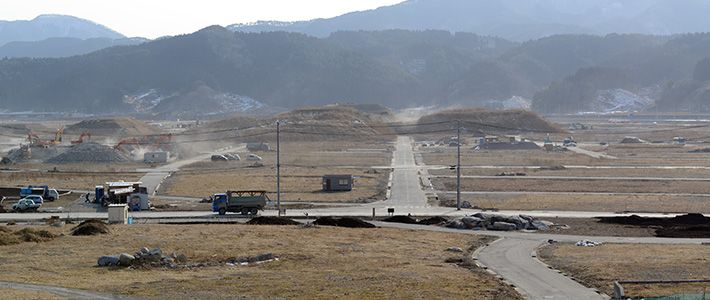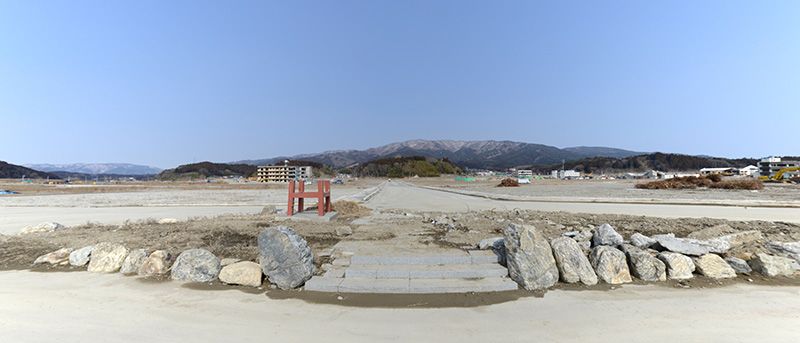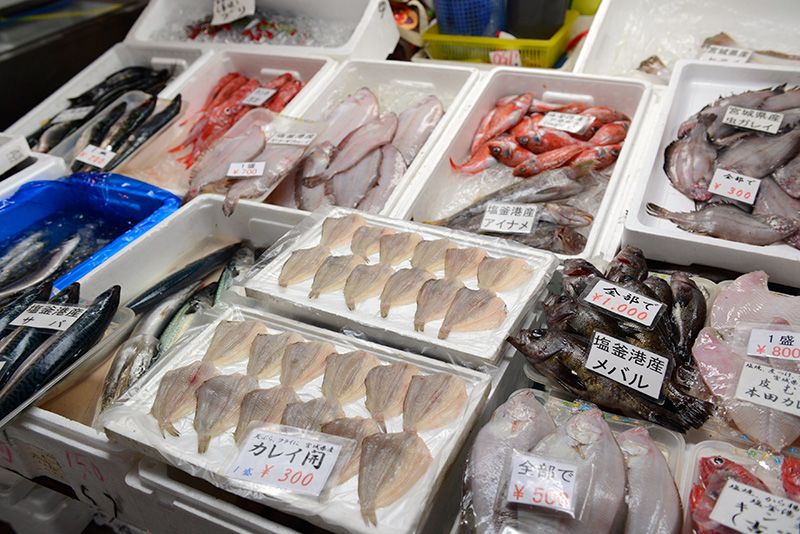
A Late Spring in Tōhoku (Part 2)
Politics Society- English
- 日本語
- 简体字
- 繁體字
- Français
- Español
- العربية
- Русский
Rikuzentakata: City and Scenic Wonder Obliterated

At a construction site in Rikuzentakata in Iwate Prefecture, I stop to talk with a young resident employed on one of the area’s “reconstruction” projects. With the sun beating down on his already sunburnt face, he helps me orient myself in a landscape almost devoid of landmarks.
“If you keep walking north from the station shopping plaza here, the road takes you up a hill with a Shintō shrine, where an old castle once stood,” he tells me. I am momentarily puzzled. Then I realize that we are standing in what was once the very heart of town—the plaza in front of JR Rikuzentakata Station. Not a trace of the station building or tracks is visible; all that remains is the skeleton of the platform.
“In the old days,” he adds, “you could look south toward the ocean and see a wide band of pine forest stretching all along the seashore.”
The two-kilometer stretch of white beach and deep-green pine forest, known as Takata Matsubara, was a nationally designated Place of Scenic Beauty and part of Rikuchū Kaigan National Park. The seashore with its 300-year-old trees was a major tourist attraction before a “once in a millennium” tsunami laid waste to the coast on March 11, 2011.
The death toll in Rikuzentakata reached 1,700. After the disaster, many of the survivors drifted away. The city’s official population currently stands at 20,000, some 4,000 less than before the disaster. Here, in what used to be the heart of the city, there is no sign of human habitation. With the exception of a handful of buildings in the process of demolition, there is nothing but weedy wasteland.
The pine forest along the seacoast has vanished as well. Also gone is the famous lone pine left “miraculously” standing after the tsunami. The towering old tree that was treasured as a symbol of hope sickened from the saltwater and had to be cut down. The city is now in the process of erecting a tree monument to take its place.
The mountains of rubble that covered the city for months have been cleared for the most part. But that oft-repeated word “reconstruction” rings a bit hollow here in central Rikuzentakata, which has yet to see the construction of a single new building.
 Vacant land stretches out in all directions from the old center of Rikuzentakata after the rubble was cleared away. On the distant hill in the center is the spot where Takata Castle once stood. The red object in the foreground is all that remains of a monument that was near the roundabout in front of JR Rikuzentakata Station.
Vacant land stretches out in all directions from the old center of Rikuzentakata after the rubble was cleared away. On the distant hill in the center is the spot where Takata Castle once stood. The red object in the foreground is all that remains of a monument that was near the roundabout in front of JR Rikuzentakata Station.
Consulting a local map, I locate the hill that the young man mentioned. About one kilometer from the station and two kilometers from the shore is a 50-meter rise with several Shintō shrines. In medieval times it was the site of Takata Castle, perched on the hillside overlooking the plains. Only those who fled uphill as far as the castle site were able to escape the towering waves—more than 15 meters high—that destroyed the town below.
I amble through the neighborhood of the old castle until I find myself in front of an unusual structure. This is Home-for-All, a community center completed just last November. It is one of six such structures erected for victims in the stricken communities of Iwate and Miyagi prefectures by a team of architects led by Itō Toyoo (Toyo Ito) at no cost to the local communities. This, one, erected in the hilly Ōishi district of Rikuzentakata, makes striking use of tall cedars blighted by saltwater from the tsunami. Each day the center draws victims living in nearby temporary housing who gather to touch base and chat.
“We wouldn’t have a place like this to meet at if it weren’t for the hard work of so many volunteers,” says Sugawara Mikiko, a local tsunami victim who helps manage the center. “But nowadays more and more out-of-towners are coming to look and ask questions, and we don’t have the personnel or the funds to deal with them all.”
Prefab Purgatory
 One of the six “Home-for-All” buildings in Rikuzentakata, designed by the world-renowned architect Itō Toyoo and a team of young architects. In August 2012, the designs for the structures were presented in the Japanese Pavilion at the 13th Venice Architecture Biennale, which was awarded the Golden Lion for Best National Participation.
One of the six “Home-for-All” buildings in Rikuzentakata, designed by the world-renowned architect Itō Toyoo and a team of young architects. In August 2012, the designs for the structures were presented in the Japanese Pavilion at the 13th Venice Architecture Biennale, which was awarded the Golden Lion for Best National Participation.
One of the local residents taking advantage of Home-for-All is 69-year-old Iwai Akira. “I come because I know other folks will be here, and it eases the loneliness. Thirteen of my old classmates died in the tsunami,” he explains.
Iwai’s home, a full 1.5 kilometers from the coast, was destroyed by the tsunami, and he was obliged to move into a tiny two-room prefab unit in a temporary housing complex built on high ground to provide transitional shelter for the victims. “It’s one thing for a person living alone like me,” he says, “but for families living together, it’s really cramped. And in the winter, it gets awfully cold. We’re all anxious about the future. Because we can’t stay in these units indefinitely.”
Under the Japan Disaster Relief Act, those provided with temporary housing are expected to move out after two years. While the government seems likely to extend that deadline, most occupants are worried about where they will go next. Iwai has considered buying a new home on high ground using his savings supplemented by a government grant, but he wonders whether it makes sense at this point. “I have two daughters, but it’s hard to say whether either will want to move in after I’m dead.”
Building Inland Housing Is No Easy Task
Most administrative officials in the stricken communities agree that housing is their biggest concern. Life cannot return to normal for the victims until they are settled in permanent housing in a safe area. And for many, that could take years.
According to figures released by the Reconstruction Agency, 310,500 earthquake and tsunami victims were living in temporary housing or other types of transitional shelter throughout the region as of February 7, 2013. When I visited Rikuzentakata in March, 5,500 local victims were housed in 2,200 temporary units within the city limits. The municipal government must deal with the collective relocation of these residents at the same time that it is struggling to rebuild the city center—city hall included—several hundred meters inland from the old site. (The city’s plan involves first regrading the new site to raise the land level by seven to eight meters and turning area formerly occupied by the center into a park.)
 Deputy Mayor of Rikuzentakata, Iwate Prefecture, Kubota Takashi.
Deputy Mayor of Rikuzentakata, Iwate Prefecture, Kubota Takashi.
Deputy Mayor Kubota Takashi left his job in the central government’s Cabinet Office to work for the city of Rikuzentakata last August, after volunteering here in the wake of the disaster. He stresses the magnitude of the housing problems facing the city.
“We finally moved the last of the homeless into temporary housing last August,” he says. “The next phase is going to take even longer. We have a plan to build public rental housing for disaster victims in the hills, but there isn’t that much land suited to housing construction, and the land we want to use is owned by quite a few different people, including some who live out of town. Reaching an agreement with all the land owners has proven very time consuming.”
The situation differs radically from that following the Great Hanshin (Kobe) Earthquake of 1995 in that many of the quake victims then had been able to rebuild their homes on the original lot. But many of the areas hit by the 2011 tsunami have been declared tsunami hazard zones by the local government and subjected to land-use restrictions. Some of the residents have begun working with private developers to build new homes at their own expense.
“In any case, we need to pick up the pace,” Kubota acknowledges. “The central government has finally simplified administrative red tape that had been hobbling reconstruction in the stricken communities. If we can assemble the needed personnel and shift budget funds to our top priorities, we should be able to move the occupants into the first permanent housing complex by the end of next year. But we’re counting on the central government to relax budget regulations to make it easier for us to reallocate funds. At the same time, we need to work on attracting businesses to the area to create jobs for our residents.”
Onagawa: Rebuilding a Sunken Port
My next stop was the town of Onagawa in eastern Miyagi Prefecture, where waves close to 20 meters high demolished the town center. Many survivors have moved elsewhere, and the town’s pre-disaster population of 10,000 has fallen by half. Although the roadways are clear, the wreckage of several concrete buildings still litters the landscape. It is barren, vacant land.
At the port of Onagawa, coastal subsidence caused the land to sink by over a meter, and the prefecture has only recently set to work regrading the land and rebuilding the port. Abe Yoshihiko, who operates a ferry between Onagawa and the outlying islands, was able to resume service in August 2011 with the aid of a temporary pier. I talk to the skipper as he prepares his ship, the Shimanagi, for departure.
“The pace of reconstruction is so slow,” he laments. “After the quake, we were thinking it might take a year to rebuild the wharf, but the initial expectations of the town office and of residents were overly optimistic. Anyway, ticket sales nowadays are about a tenth of what they were before the disaster.”
 A building knocked over by the tsunami lies on its side in Onagawa Port next to a low-lying bridge.
A building knocked over by the tsunami lies on its side in Onagawa Port next to a low-lying bridge.
In July 2011, then Mayor Azumi Nobutaka told me that one of biggest challenges the town faced was disposing of 440,000 tons of debris. That hurdle has been largely overcome, according to current Mayor Suda Yoshiaki, who replaced Azumi in November 2011. “With the help of the Tokyo Metropolitan Government, we should see the last of the burnable refuse leave here by the end of this month,” he says. “The nonburnable debris should be disposed of by the end of June.”
The next step is to rebuild the town’s roads, port facilities, and other infrastructure. But as Suda informs me, the town has a serious labor shortage, and between labor costs and the high price of concrete and other materials, the bidding on reconstruction projects frequently ends without a winner.
 Mayor of Onagawa, Miyagi Prefectue, Suda Yoshiaki.
Mayor of Onagawa, Miyagi Prefectue, Suda Yoshiaki.
“We had planned to finish rehabilitation of Onagawa Port by the end of fiscal 2014, but we may have to push that back to 2015,” Suda acknowledges. “The Ministry of Internal Affairs and Communications has sent us twenty-one of its employees to help out with municipal administration, but it’s not nearly enough. We need to lobby for more help from the prefecture and the central government alike, and that includes funding.”
With regard to housing, Suda says it will take five or six years to build enough public housing to accommodate all 1,900 households currently in temporary units. It will be at least another year before people can even begin moving in.
Onagawa’s initial general-account budget for fiscal 2012 was ¥23 billion, almost four times the pre-tsunami budget of ¥6 billion. The town’s fiscal situation has been relatively comfortable until now, thanks to subsidies provided by the central government in connection with the Onagawa Nuclear Power Station, which started up in 1984. But the plant was shut down in the wake of the earthquake and the Fukushima nuclear accident, and no one can say when it will resume operation. Meanwhile, tax revenues from the facility have dwindled owing to depreciation.
Faced with nearly overwhelming challenges on every front, Onagawa has no choice but to tackle them one at a time. Mayor Suda is determined to do whatever it takes. “As a native of this town, I care about what it’s going to look like in another twenty years, when I’m sixty. That’s why I became mayor. No matter how tough our present situation, we need to think about preserving this town’s culture and assets for future generations.”
Shiogama: Pining for Local Fisheries
On the fourth and final day of my second anniversary tour of tsunami-stricken Tōhoku, I head south toward Tokyo, stopping at Shiogama in Miyagi Prefecture. My precise destination is the Shiogama Marine Products Wholesale Center at the harbor, one of the largest fish markets in the region and key distribution center for marine products from the Sanriku region.
Fish vendor Suzuki Kiyotaka is pleased to report that his business is well on the road to recovery. After dwindling to almost nothing following the earthquake, incoming shipments rebounded to 30% or 40% of pre-quake levels by summer. “Now, they’re up at about 90 percent,” he says. “The negative publicity from the Fukushima accident is having much less impact than before, and our customers are back.”
Unfortunately, only a tiny fraction of the products sold here are from local coastal fisheries. Reconstruction of the area’s fishing ports has made little progress, and most local fishers lack the resources to replace their destroyed fishing vessels. The fish market makes up the deficit by shipping goods in from other fisheries and other markets. As the spring fishing season approaches, vendors can only hope that the local fishing industry is preparing for a gradual comeback.
Since fishing was a key industry in almost all the region’s hard-hit coastal communities, the state of the area’s fishing ports and fisheries must be seen as a measure of the recovery process as a whole. The stricken communities will need patience and persistence to overcome the sea’s horrific destruction and benefit from its blessings once again. The government and the Japanese people must be prepared to support these reconstruction efforts for years to come.
 Seafood for sale at the wholesale center in Shiogama. Incoming shipments have recovered to 90% of the pre-disaster level, but there are still few products from the Sanriku region.
Seafood for sale at the wholesale center in Shiogama. Incoming shipments have recovered to 90% of the pre-disaster level, but there are still few products from the Sanriku region.